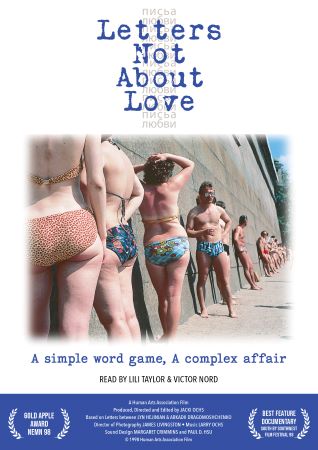
Letters not About Love 1998
Distributed by New Day Films, 22D Hollywood Ave., Hohokus, NJ 07423; 1-888-367-9154
Produced by Human Arts Association Film, Producer/Director/Editor: Jacki Ochs
Director n/a
VHS, color, 58 min.
Adult
Literature, Media Studies, Communication
Date Entered: 11/09/2018
Reviewed by Oksana Dykyj, Head, Visual Media Resources, Concordia University, MontrealThe letters of American poet Lyn Hejinian and Russian poet Arkadii Dragomoshchenko are the nucleus of this film. However, the categorization of the film raises interesting questions and possibilities. It was awarded a prize for "Best Feature Documentary" in 1998 at the South by Southwest Film Festival. It is certainly feature-film length, but it is not a documentary or non-fiction film, although it ultimately documents the poetry of two individuals from different cultures. Though not a fiction film, viewers could easily weave a variety of fictional narratives. It is not purely an experimental film either, although it is a successful experiment in meshing poetry and visual art. It is not a film about poetry or a film using poetry, it is quite simply a film-poem. We can take this further: the letters, or correspondence between the two poets, are said not to be about love, yet the video-cover art divulges what we eventually figure out, that it is effectively about universal love. Whether this was an error in cover design or another layer of Jacki Ochs' work is not clear, but the result is. The title "Letters Not About Love" is superimposed over what one would assume to be its Russian translation. Upon closer inspection one finds that the two Russian middle words, "Not About" are missing. What remains, translates grammatically as "Love Letters".
The structure of the film-poem is established and explained at the start. The two poets were asked to conduct a specific correspondence based on a list of 9 words such as home, poverty, book, and window. They were asked to reflect on each word, to consider its definition, as well as what it means to them personally. Each chapter or theme of the film is based on the invocation of a particular word. The resulting personal revelations, memories, ponderances upon philosophies, morals and ethics, construct a historical and cultural perspective while at the same time, expose the vulnerability of individuals baring themselves through words.
The words themselves are just the starting point in this multi-layered film. The words, first written by the poets, are then spoken by actors Lily Taylor and Victor Nord. The actors' performance is then layered with Jacki Ochs' images - home movies, archival material and new footage. Many of these images have their own history or meaning but it is stripped away here to be used as background or foreground for the words. The imagery does not neatly illustrate the poetry, but it could be used as a means to build yet another level of understanding. Should the viewer not want to construct an additional narrative by putting together the performed words with the images (themselves punctuated with sound layers in the form of pieces of music and sound effects), there exists the possibility of simply using the various levels of tension produced by the sweeping camera movements over urban and rural landscapes as enhancements or separate dynamics for the feelings expressed in the words.
In her preliminary thinking about the film, the filmmaker must have made the decision to have Dragomoshchenko's writing translated into English in order to facilitate the flow of words and therefore consciously or unconsciously add another layer of meaning, intent, or emphasis to the poetry through the translation itself. It is completely understandable to have done this but one cannot help but wonder what it would have been like to watch this film with a reading of the Russian segments in Russian aided by English subtitles. After all, the titles and credits are all bilingual in this film and it was a Russian-English collaboration. While the subtitles would have created an additional layer out of the current translation for the majority of viewers, they could also be seen to act as an independent layer available to the viewer who understands Russian but wants to read how the poetry translates into English. However, that would have created a different film and since subtitles are usually perceived negatively and add another level of work for the viewer, Ochs' decision to avoid chaos and translate rather than subtitle was a wise one. The loss is minimal and only for the very small purist minority of viewers with an understanding of both English and Russian.
The differences between watching a film on a big screen and on a monitor are particularly significant in relation to this work. At 58 minutes, it commands the authority to envelop the viewer with each of its layers. It demands a solemn space for its exhibition as it will lose a considerable amount of power if it is not optimally screened and it may even give the impression of being too long and repetitious if distractions prevent the viewer from reflecting as it unfolds. The film requires active participation, even if it is simply being conscious of wanting to allow it to passively wash over during certain segments. It is highly recommended for poetry and creative writing students, as well as for students in areas such as inter-related arts, cinema, and multi-media communications.